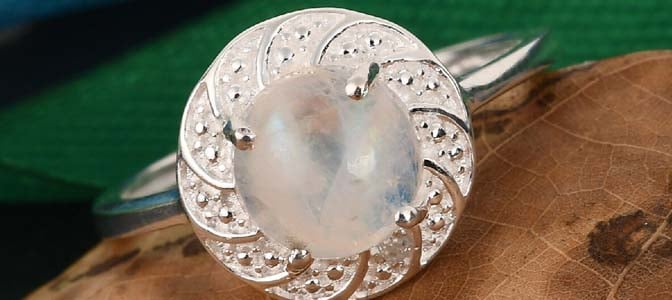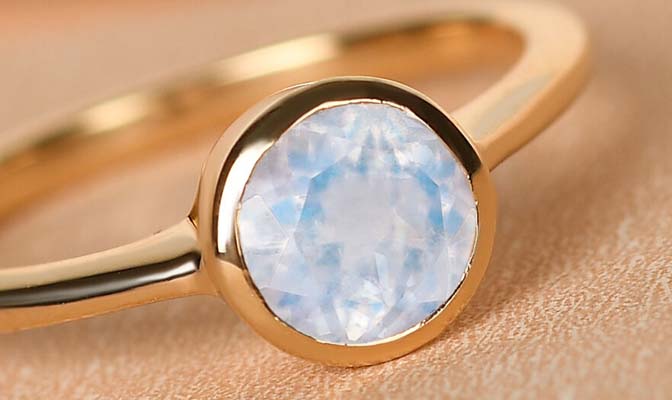Moonstone crystal is a natural mineral having the energy of the moon. The moon embodies feminine energy and promotes healing, balancing and enhancing your intuition. Moonstone mineral is the combination of two feldspar minerals which are separated into different layers. When light falls on the moonstone, it diverges between the different layers of the feldspar and causes adularescence.

Introduction
Moonstone is one such crystal that is considered sacred in many cultures. Since 2000 years long, this stone has been used in Roman jewellery. It has a special significance for lovers and used as a traditional wedding gift in some cultures. Moonstone has always been a popular choice for jewellers in the Art Nouveau period. In many parts of Europe, this stone is believed to reconcile estranged lovers and to treat sleeplessness. Moonstone has been worn as a talisman to enhance the personality as it uplifts the quality of hope.
New Arrivals in moonstone

Origin & Supply
Moonstone is member of the mineral family of feldspars. It’s an opalescent stone that can be found in colourless form as well as peach, pink, green, grey, yellow, brown, and blue. The play of light displayed by Moonstone is called adularescence, and its clarity ranges from transparent to opaque. Best quality moonstones come from Sri Lanka and India. Blue moonstones are only be found in Sri Lanka. Major moonstone mines are found in Switzerland's Adula Mountains. Other moonstone mines are found in Myanmar, Brazil, Norway, USA, Australia, Germany, Tanzania, India, and Madagascar.

Facts About Moonstone
- The moonstone is the gemstone for the 3rd wedding.
- In ancient times, the moonstone was used to evoke deep passion between lovers.
- Ancient astrologers considered that this stone can predict the future.
- The ancient Romans and Greeks considered that moonstone was originated from bits of the actual moon.
- Ayurvedic medicine and various other crystal healing methods use moonstone for healing and treatment.
- Moonstone is believed to be feminine in nature, as it is associated with the lunar cycle controlling a woman's cycle.
- Moonstone is considered to promote calmness, confidence and encourage peace, harmony and balance.
- Many people believe that moonstone and pearls are related and have identical gemstones, but it's not true. They have different mineral composition and pearls come from oysters and mussels.
- The leaders of the Art Nouveau movement brought increased interest in natural and mystical stones like moonstone.

Properties of Moonstone
The moonstone’s shifting fluorescence and mesmerising blue-white colour radiance have linked with the mystical properties of the moon. Moonstone is a form of mineral that is a part of orthoclase feldspar group and is formed by potassium aluminium silicate. This stone is distinct from other similar stones due to the presence of adularescence. Moonstone illuminates extraordinary optical phenomenon that occurs due to its special layered microstructure. The light diffraction that occurs within the layers of its microstructure creates a mystical effect, moving blue sheen. Apart from adularescence, Moonstone also displays cat’s-eye effect.
Colour: Due to the adularescence effect, the body colour of moonstone can differ ranging from transparent to blue and green. This gemstone is found in blue, grey, green, orange, pink, white, and brown colours. Most popular type of moonstones are almost colourless combined with a blue adularescence. But these days, the variety of available colours has risen due to the increasing choice of buyers.
Blue Moonstone Blue Moonstone displays a floating blue colour on its surface that is transparent and crystal clear. The largest and best blue moonstones usually come from Myanmar.
Rainbow Moonstone Rainbow moonstone displays a milky patchy appearance which comes from the white orthoclase inclusions and layers. The reflection from the layers and inclusions generates a rainbow effect when the stone attracts light. It features a rainbow-like iridescence and can be cut into a faceted gemstone as well as a cabochon.
Orange Moonstone This variety of moonstone is a rare variety of moonstone and can be only found in Sri Lanka. This stone typically features white adularescence and displays a peachy body colour.
Pink Moonstone Pink moonstones range from honey to beige to peach colours. It can be translucent to opaque. The stone has a white sheen that is often used in rows of coloured beads.
Green Moonstone Green moonstone is not as popular as a rainbow or blue moonstone. This stone doesn't display any show of colour or fluorescence. It has a little hazy or clear appearance and a pale green-yellow colour.
Titanium Moonstone This rare kind of moonstone possesses a silver or metallic colour show. This kind of moonstone is only found in Sri Lanka and available in very less quantity.
- Cut: Moonstones are usually cut into beads, cabochons or in faceted form. Mostly, the best cut for moonstone is cabochons which displays the natural phenomena of adularescence. Although, faceted moonstones are getting more popular due to its capacity of hiding inclusions inside the stone. Rose cut is the one of the most popular cuts as it illuminates the colour and texture of the stone, emphasising its depth and angles.
- Clarity: Moonstone is sometimes colourless, sometimes translucent, and sometimes perfectly transparent. Due to its feldspar property, it reflects a bluish, milky light, that has been compared to the light of the moon.
- Carat: You can find moonstones of both large and small sizes. For jewellery designs, moonstones of 1 to 5 carats are mostly preferred due to their easy availability. Clear and large-sized stones of about 15 to 20 carats are very rare to be found and they are of high value.

What to remember while buying moonstone?
- The first and perhaps the most important thing to remember is to evaluate the lustre of moonstone. It always had a light blue tone to it. A real moonstone will have a slight hint of blue lustre on top.
- You also need to remember that a moonstone scratches rather easily. It has a low rank on Mohs Scale of Hardness, which makes it susceptible to easy damage.
- Moonstone is a fairly abundant stone, so it doesn’t command a very high price. However, the metal it has been set in also needs to be considered. Vintage stones also seek a high-end price.
- The most popular form of a moonstone is a polished cabochon. Very rarely is a moonstone gem faceted.
- Always look for the correct setting when you’re buying jewellery made from moonstone gem. It’s a soft stone, so prong setting isn’t ideal. Channel and bezel setting are usually picked to keep the gem safe.
- If nothing else, always consider the 4Cs of the moonstone gemstone you’re picking. These are carat, colour, cut, and clarity.
- If you wish to know that the moonstone is real, hold it in the absence of light. Moonstone has a rare phenomenon called adularescence. It makes it appear as if the gem is almost glowing.
FAQ's
What is the meaning of Moonstone?
What are the benefits of wearing Moonstone?
It is said that moonstone benefits feminine reproductive system that promotes fertility, decreases menstrual cycle issues, promotes hormonal balance and lessens retention of fluids. Moonstone, believed by the healers, also heals degenerative diseases involving the eyes, fleshy organs, hair and skin. Moonstone helps relieve insomnia while encouraging pleasant dreams.
Is moonstone valuable?
Moonstones are not very expensive. Its price depends on a host of factors, like colour, size, quality and place from where you are buying it. Coloured moonstones often cost more than the common bluish-white moonstones.
Does Moonstone scratch easily?
Yes, they should be handled with care. Moonstones should not be contacted with cleaning agents and chemicals. Chemicals can scratch and even cause breaks in the surface of the moonstone through deterioration. While doing household chores and gyming is advised to remove your moonstone if you don't want to get it scratched by various metals.
How do you clean Moonstone?
You can clean your moonstone using saltwater. You need to leave your Moonstone overnight, submerged in a glass bowl that’s half full with saltwater. After soaking, rinse it in cool running water to remove the excess salt.
Does Moonstone fade in the Sun?
Though moonstone doesn't gets easily fade under the sun. Still, it is advised, not to keep your moonstone exposed in the sun for more than 2 hours.
What Moonstone variety is the most valuable?
White transparent colourless Moonstone with adularescence are the most valuable Moonstones with a bluish colour sheen are more valuable than the other coloured moonstones.





































